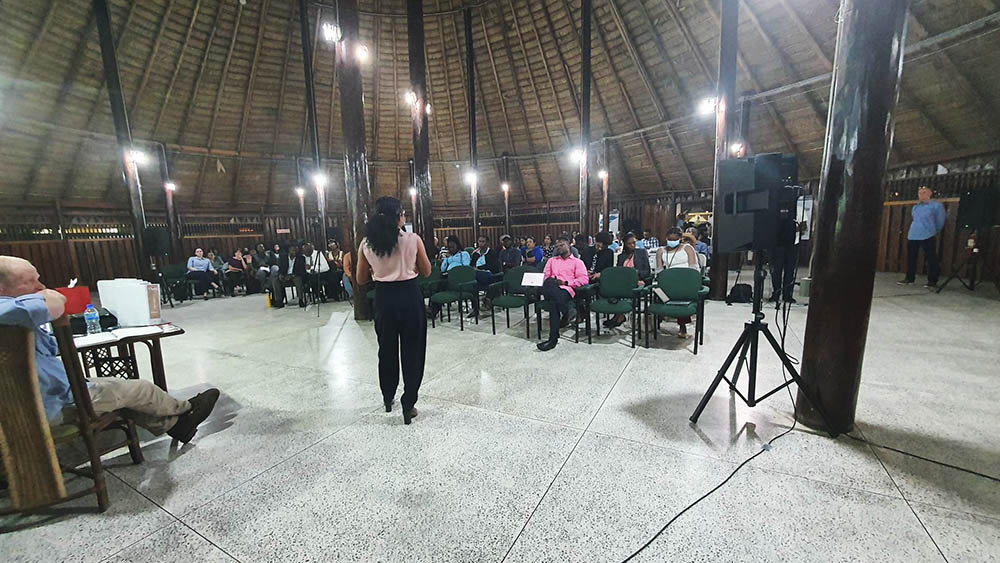Even as questions of impact on marine life and biodiversity, accumulated mercury content the crude oil contains and mitigation against oil spills were asked, yesterday’s final public meeting of ExxonMobil’s local affiliate Esso Exploration and Production Limited called for increased stakeholder participation.
Having submitted an Environmental Impact Assessment (EIA) and Statement (EIS) for its fifth project, done by consultants Acorn International, ExxonMobil is currently seeking authorisation for the project which it expects to begin production in late 2026.
The company yesterday brought to a close the in-person disclosure meetings it has hosted across the country on the project and EIA, with the final meeting held at the Umana Yana, in Kingston, Georgetown.

Attendance at the meeting was higher than at other stakeholder forums the company has held since last year and it featured a broad spectrum of persons from Region Four, ranging from geological experts, civil society activists, environmentalists, and attorneys, to persons on the street.
Acorn International hosted new strategies of communicating with the public by making available, at least eight of its staff, who focussed on various aspects of the EIA. The company also structured the meeting by giving an overview of the project, with respective persons discussing the research, findings and recommendations.
Exxon officials were peppered with questions with everything from impacts of noise pollution, air quality, waste water management, flaring, oil spill mitigation, climate and climate change, insurance liability, waste management, and marine life impact and biodiversity.
Former Commissioner of the Guyana Geology and Mines Commission (GGMC), William Woolford, questioned about the possible mercury content of the crude in the Stabroek Block, given that it is an element in the makeup and “geo-chemistry” of the unrefined petroleum.
He also asked about the water-depth of the operation in comparison to similar projects globally that had been assessed by both the company and its consultants Acorn International, in terms of oil spill modelling and preparation for unplanned events. “What is the closest similar operation, to the one that you have assessed, in terms of water depth, total depth and so on?” he asked. Woolford also expressed concern about response times along with the company having knowledge of projected areas that a possible spill would impact most.
Concerning the mercury content of the light sweet crude that ExxonMobil boasts about, the company’s representatives admitted that they were not currently aware if it did contain mercury, and if so, what the percentage was. They however committed to conducting further research on this topic.
Regarding water depth, Acorn said they would have to check, however, a representative who worked with another company said they had done similar modelling in Trinidad and Tobago, The Bahamas, and on the Gulf of Mexico’s Deep Water Horizon. She said that they would have to check on the depth of each of them but that lessons learned from looking at that spill, along with assessments from other countries, has seen them “learn from that.”
“Industry in general have taken a lot from the horrible event like that [the Deep Water Horizon spill],” she said.
Acorn noted that in its independent assessment to the EPA, its strategy was to have broad consultations with Guyanese and it was glad that it did as the participation was the focal point for a lot of its research and assisted in the formation of the report.
Giving a non-technical summary of the project, Acorn related that with the project including up to three drill ships drilling up to 63 wells to serve a dedicated 2 million barrels of oil per day (boe) capacity FPSO and producing at 250,000 barrels of oil per day, most of the impacts were negligible.
However, the project which includes drilling, installation, commissioning and start-up, production and decommissioning, may have potential impacts on physical, biological, and socioeconomic resources or receptors.
According to Acorn, these resources or receptors are not limited to air quality, climate, climate change, marine water quality, marine benthos and marine geology, and sediments, seabirds, marine fish, riverine mammals, marine turtles, employment and livelihoods, community health and wellbeing, and waste management and infrastructure capacity, among others.
Civil society activist, Danuta Radzik, sought answers as to why with four volumes of the EIA that only one was uploaded to the EPA’s website. The EPA has been continuously late in uploading projects as it would sometimes advertise that a project could be found on its website but it would take days or calls to the agency before it was uploaded.
Radzik also wanted ExxonMobil and Acorn to point to their referenced maps on sensitive resources, since that too she had difficulty highlighting, and for them to state the impact the project would have on spawning fishes and their nurseries along with offshore reefs.
The activist also suggested that the company should make public, the amount of waste per barrel of oil produced, given that increased production will see increased waste, and worryingly hazardous ones.
Guyana’s offshore murky tepid waters are not the tropical and subtropical kind conducive to corals, according to Acorn, and thus reefs are not found where the operations are projected to be.
Citizen Kalima Ali made reference to historical data used for oil spill projection mapping in the EIA and advised that given climate change changes, that the company needs to also periodically update the data it was using.
Attorney Elizabeth Hughes who has been vocal on all of the projects, again outlined a number of concerns including waste management.
Acorn has said that the Uaru oil field development project during its production stage will discharge a significant amount of chemicals into the ocean.
“Based on the estimated discharge rates, cooling water, produced water, slop discharge overboard, and brines from the sulphate removal, ultrafiltration, and wash water processing system, are the operational discharges that are significant enough to require assessment, and thus these were the focus of modelling to assess the nature and extent of potential marine water quality impacts,” the document states. It was noted that a 20 per cent contingency factor was added to most of these discharge rates for the modelling to provide conservatism for the assessment.
“Additionally, although the discharge of hydro test water and commissioning fluids will occur over only a short time period during the SURF installation and commissioning stage, they were also included in the offshore discharge modelling as a conservative approach to assessing potential impacts,” added the EIA. Potential impacts from the other effluent discharges listed in the EIA were considered to be negligible. It was estimated that 2,264,332 barrels of cooling water would be discharged per day, 300,000 (barrels per day) bpd produced water, 315,000 bpd of sulphate removal, ultrafiltration and wash water processing brines, and 1,800 bpd of FPSO bilge among other chemicals. The consultants noted that effluent characteristics and volumes/rates are based on the preliminary project design information available at the time of the EIA.
“While the expected volume of off-specification oil will be negligible, if it rains significantly, the expected discharge volume for this stream would increase,” the EIA added.
Other persons asked questions on gas utilisation for the project, and were told that a plan for the project gases will be submitted sometime this year to government.
According to the EIA the Project will develop the Uaru and other discoveries – Mako and Snoek fields simultaneously. However, there is potential to develop other resources within the licensed area. The Uaru Development Project will add at least 1.3 billion barrels of oil to the already more than 10 billion in oil recoveries in Guyana.
The cost is approximately $12.683 billion and includes the drilling of 38 to 63 wells, installing and operating subsea, umbilicals, risers, and flowlines (SURF) equipment, and use of a Floating Production, Storage, and Offloading (FPSO) vessel to process, store, and offload the recovered oil. The FPSO will be anchored in place and will be connected to the wells via SURF equipment to transfer produced and associated fluids from production wells to the FPSO, as well as treated gas and water from the FPSO to the injection wells.
It was stated that the proposed FPSO will be a newly-built floating facility with double-hull protection, whose approximate dimensions is expected to be 354 metres (1,161 feet) long by 64 metres (210 feet) wide by 33 metres (108 feet) deep. According to the EIA, the exact locations of the Uaru development wells have not yet been finalised; however, the wells will be drilled from ten drill centres. The Project life cycle consists of three main phases: Drilling and Installation, Production Operations, and Decommissioning.
It has been estimated that the Project will require a workforce of approximately 540 persons at peak of the development well drilling, 600 persons at the peak of the installation phase, 100 to 160 persons at peak of production operations with an additional 25 to 30 personnel on board each export tanker, and 60 persons at the peak of decommissioning.
The drilling of the 38 to 63 wells, is expected to take several years, with drilling currently scheduled from mid-2024 through 2029. Installation of the SURF and FPSO is expected to start in 2025 to be ready for initial production by late 2026, with operations continuing for at least 20 years.
The EIA can be downloaded from the EPA’s website.





